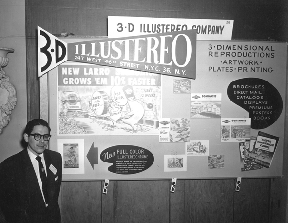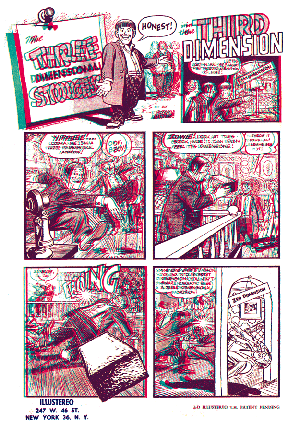

A recent communication from Leonard Maurer, brother of Norman Maurer, sheds new light on the invention of 3-D comics in 1953. In most histories, the credit for the creation of 3-D comics is largely given to cartoonists Joe Kubert and Norman Maurer, but Leon's role is more significant than these histories have suggested. Here, in a slightly abridged form, is Leon's version of the 3-D comics history:
"Even though it was Joe's remark, 'Gee, wouldn't it be great if we could make a 3-D comic book?' (when he, Norm and I were driving past the marquee of the Paramount Theater where Bwana Devil was playing) that got me thinking about 3-D comics. At the time, Norman was visiting New York to work out a normal 10 cent book editing deal for him and Joe. Later, while driving home to Queens over the Midtown bridge, the whole process [of] depth shifts suddenly popped into my head.
"With the idea fully formed in my head, I immediately turned around, picked up some acetates, went back to Norm's hotel room, and explained the process to him. We then collaborated on a short, short story, and he went immediately to work with pencil, brush, ink and paint, following my technical instructions while I did the opaqueing. Around 2:00 AM we finished the real World's First 3-D comic book page entitled, 'The Three Stooges in the Third Dimension' starring Moe, Shemp and Larry.
"When Norm was done, I slept over in his room, and at the crack of dawn, drove straight out to my plate-maker, and then to my company (where I was the advertising manager, with an in-house print shop) -- mixed the ink colors, and finished the job. At 11:00 AM, I rushed back to Manhattan, picked up some EK-Wratten filters at a camera shop... and, it was that page that Joe first saw that afternoon, and which later, we presented to Archer St. John as co-inventors. We gave St. John a 25 percent partnership in our licensing company, along with a 6 month's head start for his publishing company in exchange for financial guarantees for Norman and Joe as Editors, and myself, as supervising producer -- with a secret studio to be set up for production of the Mighty Mouse book.

"I didn't realize that the 6 month's exclusive was what triggered Sol Harrison, Stan Lee and all the others to knock us off as quickly as they could, since my hands were tied in offering everyone a license. I could understand them doing this, however, since the success of Mighty Mouse, with its precision offset printing, along with my carefully designed and engineered die cut glasses insert, and selling for a quarter with the same number of pages as a dime book, was big, big news. And there were equally big financial stakes involved...especially, since it had an unheard of 100 percent sellout of its initial 1,000,000 print order. We even had to reprint an additional million.
"That was some leap. Considering that the normal print order at the time was under 300 thousand. All of this was based on our combined advice and suggestions to St. John. I also warned him not to go too far overboard with the next books, since I didn't think the fad would last more than two seasons. I recognized the danger of off register [printing] too, especially in the 'y' axis, and knew that as soon as they tried to do it on the standard comic book web letterpresses, with their notoriously poor registration, the resultant headaches would bust the whole market apart.
"What eventually bankrupted St. John was his attempt to block all the other publishers by buying up, in carload quantities, all the factory output for over 6 months of dyed acetate (made to my specifications, and produced by Celanese Corp.) He also bought up carload quantities of comic book newsprint paper. He didn't succeed in blocking everybody, since there were other major acetate and paper manufacturers, but he did hold up a few, and for a while, his books were of the best quality and led the market.
"The only problem I had, was not being allowed to use low acid paper for the initial printing, although he went along with most of my other suggestions. My beef today is that if he had allowed me to use low acid paper, my last few mint copies of the pioneering Mighty Mouse book wouldn't be so browned out."
first published in 3D News the Newsletter of the Stereo Club of Southern California,May 2001
